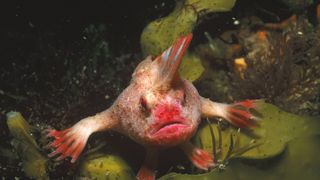RIP, smooth handfish. You were weird, and now you’re extinct.
These fish used to be commonly found off the Tasmanian coast.

An unusual-looking fish with bulging eyes, a mohawk-like fin on its head and the ability to walk on the seafloor with its pectoral and pelvic fins has reached a grim milestone. The so-called smooth handfish (Sympterichthys unipennis) has been declared extinct, the first modern marine fish on record to completely vanish, according to the International Union for Conservation of Nature (IUCN).
A mere 200 years ago, the smooth handfish was so plentiful in Australia — where it basked in Tasmania's warm, coastal waters — that it was among the first fish species to be scientifically documented Down Under. In 1802, French naturalist François Péron nabbed the first specimen of the odd-looking creature with a dip net in southeastern Tasmania, a feat that worked because handfish live in shallow waters, the IUCN said in a statement.
Now, Péron's specimen (which you can see here) is the only smooth handfish scientists have left to study. It's not that researchers haven't been looking. Despite extensive underwater surveys along the Australian coastline, the smooth handfish hasn't "been sighted for over 200 years," meaning that Péron was the only scientist on record to collect one, according to a 2017 study in the journal Biological Conservation.
Related: Photos: The freakiest-looking fish
With the extinction of the smooth handfish, just 13 other handfish species remain alive. All of the fish live on the seafloor, where they use hand-like fins to "walk." These fish are now so rare, conservationists gleefully announced to the world that they had found a previously unknown population of the red handfish (Thymichthys politus) consisting of between 20 and 40 individuals in 2018, Live Science previously reported.
Handfish are anglerfish, meaning they're relatives of the deep-sea anglerfish, the toothy beast that has a luminous bulb dangling from its head, according to Scientific American. Though "walking" fish don't sport a glowing light, they do have another cool trick that awes scientists: Their babies don't have a larval stage. Instead, handfish give birth on the seafloor to fully formed juveniles, according to Fauna & Flora International (FFI), a conservation organization based in the U.K.
Moreover, the handfish are homebodies; they don't have a big habitat. In other words, if their areas are disturbed, the handfish have nowhere else to go.
Sign up for the Live Science daily newsletter now
Get the world’s most fascinating discoveries delivered straight to your inbox.
"They spend most of their time sitting on the seabed, with an occasional flap for a few meters if they're disturbed," Graham Edgar, a marine ecologist at the University of Tasmania, told Scientific American. "As they lack a larval stage, they are unable to disperse to new locations — and consequently, handfish populations are very localized and vulnerable to threats."
According to the IUCN, handfish are threatened by the usual suspects that endanger sea life, including fishing, pollution, the spread of the invasive northern Pacific seastar (Asterias amurensis) and habitat destruction. In particular, a historic scallop fishery that operated in the region until 1967 led to the deaths of many handfish, mostly by dredging the fishes' habitat and through bycatch (throwing away unintentionally caught fish, which often leads to those fishes' deaths), the IUCN reported.
The Handfish Conservation Project marked the fish's extinction with a tweet on March 19, saying, "@IUCNRedList has updated listings of all #handfish (Family Brachionichthyidae). Includes the first ever marine bony fish to be listed as #extinct (Smooth Handfish, Sympterichthys unipennis)."
@IUCNRedList has updated listings of all #handfish (Family Brachionichthyidae). Includes the first ever marine bony fish to be listed as #extinct (Smooth Handfish, Sympterichthys unipennis). https://t.co/iUH33SyBKJ#conservation #extinction(📷Red handfish, J. Stuart-Smith) pic.twitter.com/iuGZMXTwQrMarch 19, 2020
Meanwhile, no one has reported seeing the related Ziebell's handfish in more than a decade, the Handfish Conservation Project noted. But there is hope for another species, the red handfish (pictured above). That species has two known populations off the southeastern coast of Tasmania, and now young red handfish are also being raised in captivity in Tasmania, according to The Wonder Weekly, a publication put out by the University of Tasmania and the Tasmanian government.
Originally published on Live Science.

Laura is the archaeology and Life's Little Mysteries editor at Live Science. She also reports on general science, including paleontology. Her work has appeared in The New York Times, Scholastic, Popular Science and Spectrum, a site on autism research. She has won multiple awards from the Society of Professional Journalists and the Washington Newspaper Publishers Association for her reporting at a weekly newspaper near Seattle. Laura holds a bachelor's degree in English literature and psychology from Washington University in St. Louis and a master's degree in science writing from NYU.
Most Popular

